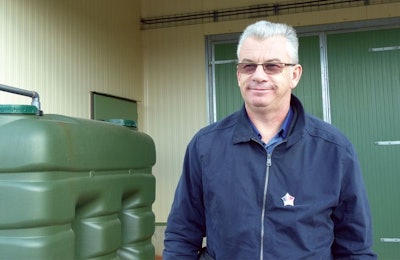
Stephane Dahirel produces broilers and turkeys without antibiotics in Brittany, home to approximately one-third of France’s production.
An independent poultry producer whose birds go to McDonald’s and supermarkets, he cherishes his independence, citing it as being key in being able to switch to antibiotic-free production, and performance data would appear to show that his approach is working.
Dahirel and his wife operate five poultry houses and produce 210,000 birds per cycle, with the help of an additional farm hand when needed and, unusually for France, produce heavier birds.
Independent action
The decision to stop using antibiotics was Dahirel’s own, and not taken in response to consumer pressure.
Dahirel explains: “I did not want to simply reduce antibiotic use, but stop producing with them altogether. The result of complete withdrawal has given us better results.”
Feed conversion on the farm across males and females is on average 1.68, comfortably within the range of 1.56 to 1.80 that might normally be expected. Daily weight gain averages 74.5 g.
Mortality rates are low – an average of 4.39 percent – clearly below the 5 percent figure generally considered to be good. Rejects stand at 0.7 percent, comfortably within the average of 0.3-1.15 percent. An average of 48.5 kg of chicken is produced per square meter.
Phophylactic antibiotic use has been stopped, as well as for therapy. According to Dahirel, there are no diseases on the farm. Vaccination is carried out to prevent viral infections, such as Gumboro disease and infectious bronchitis, and perhaps the only issue is colbacillosis. If problems arise, then phytotherapeutic products are used.
But to be in this position requires careful preparation.
Prevention, not cure
The two main strands to Dahirel’s antibiotic-free poultry production are stringent biosecurity and water treatment.
All five houses, to which access is strictly controlled, have concrete floors, unusual in France where only 10 percent of poultry houses use concrete as a flooring, but which Dahirel believes is more hygienic.
As soon as a batch of birds is sent to slaughter, their house is immediately sanitized. Within 2-3 hours, houses are cleaned with a detergent foam. Subsequently, they are disinfected for 45 minutes with fungicides, bactericides and viricides applied via spray. Houses are closed to prevent the entry of people and animals.
New bedding – buckwheat husks at 2 kg/m2 – is blown in to prevent the unnecessary entry of people or machines that might result in contamination.
To ensure that bedding remains dry, the in house temperature is initially set to 38 C, and then lowered in stages to 35 C and then 32 C.
Once houses are restocked, Dahirel is able to monitor them and control temperatures and ventilation using a smartphone or tablet. Via in-house cameras, bird movements can be monitored to observe any potential health issues.
Water is treated with hypochlorous acid to break down contamination, including microorganisms, and Dahirel believes this is key.
















